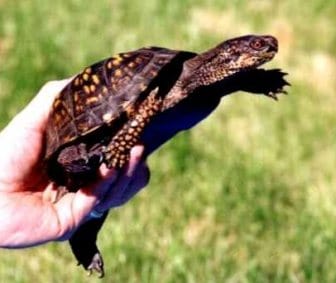This section provides an overview of terms used on this page and in turtle care in general that may not be self-explanators. The terms are listed alphabetically.
AMBIENT TEMPERATURE – Surrounding temperature; room air temperature
ASPIRATE – Inhaling fluids into the lungs
AQUATIC – Lives in, or mostly in, water
BASKING LIGHT – A light or overhead heating element that produces an area of higher heat in an enclosure; required by the reptile for digestion
BEAK – Hard or bony mouthparts on chelonians
BRUMMATION – Torpor induced by prolonged periods of low temperatures
CARAPACE – Top part of shell in turtles and tortoisesCAUDALTowards the tail end of the body
CHELONIAN – Collective term referring to turtles and tortoises
CLOACA – Passage used for eliminating fecal, urinary and reproductive discharges
DEHYDRATION – Reduction of water in body tissues and blood; can be life-threatening
DIURNAL – Active during the day
DYSTOCIA – Abnormal or difficult labor or egg laying
ECTOPARASITE – Parasites living outside (or on) the body
ECTOTHERMIC – “Cold-blooded”-body temperature varies according to ambient external temperatures
ECTOTHERM – Having to regulate internal body temperature by seeking out different external heat sources
ENDOPARASITE – Parasites living inside the body
ESTIVATION – Torpor brought on by extended periods of drought or heat
GLOTTIS – Opening at the back of the tongue leading into the trachea (wind pipe)
HERPETOLOGY – The study of reptiles and amphibians
HERPA – reptile or amphibian. “Herpers” refers to people who are interested in or who keep herps. Herpetoculture refers to the keeping and breeding of herps
HEPATIC – Relating to the liver
HIBERNATION – Torpor brought on by extended cold temperatures
HYPOVITAMINOSIS – A condition of vitamin deficiency
INGUINAL POCKETS – The area of concealed skin between the legs and shell of turtles
KEEL – The ridge of keratin found on the midline of the carapace of Terrapene carolina
MANDIBLE – Lower jaw
MAXILLA – Upper jaw
MEDIAL – Toward the midline (center) of the body
NECROTIC – Dead skin or tissue, often the result of burns or infection
NEPHROTOXIC – Chemically damaging to the kidneys
OMNIVORES – Eats live prey and plants
OSTEOMALACIA – Softening of the bones
OVIPAROUS – Reproduces by laying eggs
PATHOGEN – Disease-causing organism
PHOTOPERIOD – Day/night cycle of light/dark
PLASTRON – The bottom part of a turtle or tortoise shell
PROLAPSE – Expulsion of internal organ from the vent; can be harmful
RENAL – Relating to the kidneys
SCUTES – The individual segments of the turtle’s shell
SEMI-AQUATIC – Lives on land but spends some or much time in water
SUBCUTANEOUS – Just beneath the skin (as in SQ, subq, subcutaneous fluids)
TEMPERATURE GRADIENT – A range of temperature needed to enable a reptile to regulate its internal (core) body temperature
TERRESTRIAL – Lives on land
THERMOREGULATE – In reptiles, their ability to change their body temperature by moving from warm to cool places
ULTRAVIOLET (UV) LIGHT – UV is present in sunlight and is necessary for maintaining adequate levels of active vitamin D in box turtles
URATES – The non-fecal part of the excreta
VENT – Exterior opening of the cloaca; anus
VENTRAL – Towards the belly
VERTEBRATE – Animals having backbones (mammals, birds, reptiles, amphibians, fish)


3 thoughts on “Box Turtle Care Glossary”
Comments are closed.